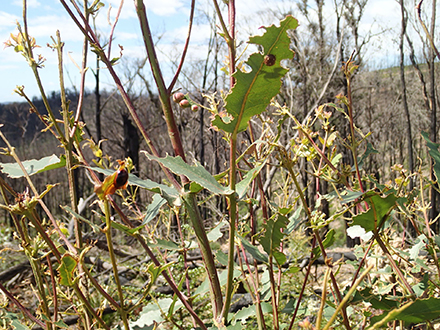
Insect plagues defoliating regrowth in the aftermath of Black Summer. Koalas breed and disperse more slowly than insects but will irrupt again within a decade or so.
Deputy Premier John Barilaro has ‘kissed and made up’ with Environment Minister Matt ‘Green’ Kean after taking time off on ‘stress leave’ last year. On Monday he told a reporter “I believe in climate change” and reportedly opened the door to shutting down logging of old-growth forest as part of his reconciliation with North Shore Liberals.Source: Vic Jurskis
Logging old growth has actually been banned in NSW for many years, but grossly inaccurate mapping has been used for enforcement. This is similar to the proposed koala protection policy that ignited the original firestorm. Curiously there was no mention of koalas.
However, a day later, the Government quietly released its response, dated December 2020, to the upper house Koala Inquiry, conducted whilst Black Summer raged 12 months ago. The holocaust was fuelled by unprecedented accumulation of fuels in the absence of sustainable forest management, but it demonstrated that koalas are in no danger of extinction.
Nevertheless, the Government agrees with the Committee’s report, that we should take action to increase koala numbers over the next 30+ years with an aim of doubling the population by 2050. “The NSW Government is working with the Office of the NSW Chief Scientist and Engineer, together with a panel of experts, to ensure the new strategy is informed by the best available science and expertise.”
However, it is an historical and scientific fact that there are many more koalas across a much wider range than there were before Europeans arrived. The experts seemingly don’t know how many, where or why. Fifteen actually admitted in a scientific journal that they made-up the numbers which have since been used to inform the Chief Scientist and the Koala Inquiry. These experts claimed to have derived “quantitative, scientific” estimates of koala populations and trends across Australia “in the absence of empirical data”.
Koalas are an irruptive species which proliferates in dense young forests or other forests thickening and declining in the absence of maintenance by mild fire.
They breed up as fuels accumulate while mature canopies decline and lose resilience. Populations crash when canopies either succumb to severe drought or are incinerated in megafires or both.
The Government Response fully “supported” 11 of the 42 recommendations from the Koala Inquiry:
Seven of the 11 were to ‘protect’ koala habitat – that is lock it up and let it burn – in habitats and corridors in private lands, urban bushland, Georges River National Park and so on.
Another was to rule out logging of old growth. This was done long ago.
Two of the supported recommendations were to plant either timber plantations or wildlife habitat and corridors on ‘degraded’ lands.
The folly of this is evident in the problems with unsustainably dense koala populations in blue gum plantations in the Green Triangle of SA/VIC and Kangaroo Island. It’s also obvious in the crash of unsustainably dense populations in amenity plantings at Gunnedah – Liverpool Plains during the Millennium Drought.
The Government also supported the strange Recommendation 21 which was to collaborate with Aboriginal practitioners to “document” the benefits of traditional burning. Lack of mild burning across the landscape caused the devastation of Black Summer. It’s long past time for action.
Here’s the final recommendation, also supported by Government:
“That the NSW Government ensure that the NSW Koala Strategy: Bushfire Recovery Plan contains as its key focus, the protection of koala habitat.” If we had proper protection of habitat for all animals, we would have much lower, sustainable populations of koalas and no need for ‘bushfire recovery plans’.
When Mr Barilaro says “Not everyone’s going to be dancing in the wheatfields” it’s something of an understatement.
To read the story as it appeared in The Sydney Morning Herald https://www.smh.com.au/environment/climate-change/i-believe-in-climate-change-how-barilaro-s-new-bromance-with-kean-changed-nationals-policy-20210108-p56sq5.html
* Vic Jurkis is a former senior NSW Forestry Commission professional forester. In 2004 he was awarded a Fellowship by the Joseph William Gottstein Memorial Trust, to investigate eucalypt decline across Australia. He has published two books, Firestick Ecology, and The Great Koala Scam, both available from Connor Court.






